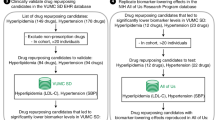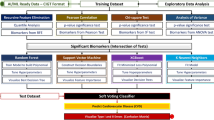Abstract
Biomarkers that can be measured in preclinical models in a high-throughput, reproducible manner offer the potential to increase the speed and efficacy of drug development. Development of therapeutic agents for many conditions is hampered by the limited number of validated preclinical biomarkers available to gauge pharmacoefficacy and disease progression, but the validation process for preclinical biomarkers has received limited attention. This report defines a five-step preclinical biomarker validation process and applies the process to a case study of diabetic retinopathy. By showing that a gene expression panel is highly reproducible, coincides with disease manifestation, accurately classifies individual animals and identifies animals treated with a known therapeutic agent, a biomarker panel can be considered validated. This particular biomarker panel consisting of 14 genes (C1inh, C1s, Carhsp1, Chi3l1, Gat3, Gbp2, Hspb1, Icam1, Jak3, Kcne2, Lama5, Lgals3, Nppa, Timp1) can be used in diabetic retinopathy pharmacotherapeutic research, and the biomarker development process outlined here is applicable to drug development efforts for other diseases.
This is a preview of subscription content, access via your institution
Access options
Subscribe to this journal
Receive 6 print issues and online access
$259.00 per year
only $43.17 per issue
Buy this article
- Purchase on Springer Link
- Instant access to full article PDF
Prices may be subject to local taxes which are calculated during checkout





Similar content being viewed by others
Abbreviations
- DR:
-
diabetic retinopathy
- STZ:
-
streptozotocin. (A full listing of gene names is given in Supplementary Table S1)
References
Lewin DA, Weiner MP . Molecular biomarkers in drug development. Drug Discov Today 2004; 9: 976–983.
Stoughton RB, Friend SH . How molecular profiling could revolutionize drug discovery. Nat Rev Drug Discov 2005; 4: 345–350.
Kola I, Landis J . Can the pharmaceutical industry reduce attrition rates? Nat Rev Drug Discov 2004; 3: 711–715.
Biomarkers Definitions Working Group. Biomarkers and surrogate endpoints: preferred definitions and conceptual framework. Clin Pharmacol Ther 2001; 69: 89–95.
Williams SA, Slavin DE, Wagner JA, Webster CJ . A cost-effectiveness approach to the qualification and acceptance of biomarkers. Nat Rev Drug Discov 2006; 5: 897–902.
Rolan P, Atkinson Jr AJ, Lesko LJ . Use of biomarkers from drug discovery through clinical practice: report of the Ninth European Federation of Pharmaceutical Sciences Conference on Optimizing Drug Development. Clin Pharmacol Ther 2003; 73: 284–291.
Lesko LJ, Atkinson Jr AJ . Use of biomarkers and surrogate endpoints in drug development and regulatory decision making: criteria, validation, strategies. Annu Rev Pharmacol Toxicol 2001; 41: 347–366.
Gunther EC, Stone DJ, Gerwien RW, Bento P, Heyes MP . Prediction of clinical drug efficacy by classification of drug-induced genomic expression profiles in vitro. Proc Natl Acad Sci USA 2003; 100: 9608–9613.
Gunther EC, Stone DJ, Rothberg JM, Gerwien RW . A quantitative genomic expression analysis platform for multiplexed in vitro prediction of drug action. Pharmacogenomics J 2005; 5: 126–134.
Mayburd AL, Golovchikova I, Mulshine JL . Successful anti-cancer drug targets able to pass FDA review demonstrate the identifiable signature distinct from the signatures of random genes and initially proposed targets. Bioinformatics 2008; 24: 389–395.
Diabetes Control and Complications Trial Research Group. The effect of intensive treatment of diabetes on the development and progression of long-term complications in insulin-dependent diabetes mellitus. The Diabetes Control and Complications Trial Research Group. N Engl J Med 1993; 329: 977–986.
Mohamed Q, Gillies MC, Wong TY . Management of diabetic retinopathy: a systematic review. JAMA 2007; 298: 902–916.
Csaky KG, Richman EA, Ferris III FL . Report from the NEI/FDA Ophthalmic Clinical Trial Design and Endpoints Symposium. Invest Ophthalmol Vis Sci 2008; 49: 479–489.
Gao BB, Clermont A, Rook S, Fonda SJ, Srinivasan VJ, Wojtkowski M et al. Extracellular carbonic anhydrase mediates hemorrhagic retinal and cerebral vascular permeability through prekallikrein activation. Nat Med 2007; 13: 181–188.
Kim SJ, Kim S, Park J, Lee HK, Park KS, Yu HG et al. Differential expression of vitreous proteins in proliferative diabetic retinopathy. Curr Eye Res 2006; 31: 231–240.
Jackson GR, Owsley C . Visual dysfunction, neurodegenerative diseases, and aging. Neurol Clin 2003; 21: 709–728.
Gerhardinger C, Costa MB, Coulombe MC, Toth I, Hoehn T, Grosu P . Expression of acute-phase response proteins in retinal Muller cells in diabetes. Invest Ophthalmol Vis Sci 2005; 46: 349–357.
Joussen AM, Huang S, Poulaki V, Camphausen K, Beecken WD, Kirchhof B et al. In vivo retinal gene expression in early diabetes. Invest Ophthalmol Vis Sci 2001; 42: 3047–3057.
Brucklacher RM, Patel KM, VanGuilder HD, Bixler GV, Barber AJ, Antonetti DA et al. Whole genome assessment of the retinal response to diabetes reveals a progressive neurovascular inflammatory response. BMC Medical Genomics 2008; 1: 26.
Duh EJ, Yang HS, Haller JA, De JE, Humayun MS, Gehlbach P et al. Vitreous levels of pigment epithelium-derived factor and vascular endothelial growth factor: implications for ocular angiogenesis. Am J Ophthalmol 2004; 137: 668–674.
Hernandez C, Segura RM, Fonollosa A, Carrasco E, Francisco G, Simo R . Interleukin-8, monocyte chemoattractant protein-1 and IL-10 in the vitreous fluid of patients with proliferative diabetic retinopathy. Diabet Med 2005; 22: 719–722.
Antonetti DA, Barber AJ, Khin S, Lieth E, Tarbell JM, Gardner TW . Vascular permeability in experimental diabetes is associated with reduced endothelial occludin content: vascular endothelial growth factor decreases occludin in retinal endothelial cells. Penn State Retina Research Group. Diabetes 1998; 47: 1953–1959.
Krady JK, Basu A, Allen CM, Xu Y, LaNoue KF, Gardner TW et al. Minocycline reduces proinflammatory cytokine expression, microglial activation, and caspase-3 activation in a rodent model of diabetic retinopathy. Diabetes 2005; 54: 1559–1565.
US Food and Drug Administration. Guidance for Industry: Pharmacogenomic Data Submissions 2005.
Freeman WM, Patel KM, Brucklacher RM, Lull ME, Erwin M, Morgan D et al. Persistent alterations in mesolimbic gene expression with abstinence from cocaine self-administration. Neuropsychopharmacology 2008; 33: 1807–1817.
Livak KJ, Schmittgen TD . Analysis of relative gene expression data using real-time quantitative PCR and the 2(-Delta Delta C(T)) Method. Methods 2001; 25: 402–408.
Fort PE, Freeman WM, Losiewicz MK, Singh RS, Gardner TW . The retinal proteome in experimental diabetic retinopathy: up-regulation of crystallins and reversal by systemic and periocular insulin. Mol Cell Proteomics 2009; 8: 767–779.
Reiter CE, Wu X, Sandirasegarane L, Nakamura M, Gilbert KA, Singh RS et al. Diabetes reduces basal retinal insulin receptor signaling: reversal with systemic and local insulin. Diabetes 2006; 55: 1148–1156.
VanGuilder HD, Brucklacher RM, Patel K, Ellis RW, Freeman WM, Barber AJ . Diabetes downregulates presynaptic proteins and reduces basal synapsin I phosphorylation in rat retina. Eur J Neurosci 2008; 28: 1–11.
Barber AJ, Lieth E, Khin SA, Antonetti DA, Buchanan AG, Gardner TW . Neural apoptosis in the retina during experimental and human diabetes. Early onset and effect of insulin. J Clin Invest 1998; 102: 783–791.
Gastinger MJ, Singh RS, Barber AJ . Loss of cholinergic and dopaminergic amacrine cells in streptozotocin-diabetic rat and Ins2Akita-diabetic mouse retinas. Invest Ophthalmol Vis Sci 2006; 47: 3143–3150.
Antonetti DA, Barber AJ, Bronson SK, Freeman WM, Gardner TW, Jefferson LS et al. Diabetic retinopathy: seeing beyond glucose-induced microvascular disease. Diabetes 2006; 55: 2401–2411.
Golub TR, Slonim DK, Tamayo P, Huard C, Gaasenbeek M, Mesirov JP et al. Molecular classification of cancer: class discovery and class prediction by gene expression monitoring. Science 1999; 286: 531–537.
Lauritzen T, Frost-Larsen K, Larsen HW, Deckert T . Two-year experience with continuous subcutaneous insulin infusion in relation to retinopathy and neuropathy. Diabetes 1985; 34 (Suppl 3): 74–79.
Waltman S, Krupin T, Hanish S, Oestrich C, Becker B . Alteration of the blood-retinal barrier in experimental diabetes mellitus. Arch Ophthalmol 1978; 96: 878–879.
Kernell A, Arnqvist H . Effect of insulin treatment on the blood-retinal barrier in rats with streptozocin-induced diabetes. Arch Ophthalmol 1983; 101: 968–970.
Asnaghi V, Gerhardinger C, Hoehn T, Adeboje A, Lorenzi M . A role for the polyol pathway in the early neuroretinal apoptosis and glial changes induced by diabetes in the rat. Diabetes 2003; 52: 506–511.
Kowluru RA, Chakrabarti S, Chen S . Re-institution of good metabolic control in diabetic rats and activation of caspase-3 and nuclear transcriptional factor (NF-kappaB) in the retina. Acta Diabetol 2004; 41: 194–199.
Li Y, St John MA, Zhou X, Kim Y, Sinha U, Jordan RC et al. Salivary transcriptome diagnostics for oral cancer detection. Clin Cancer Res 2004; 10: 8442–8450.
Havrilesky LJ, Whitehead CM, Rubatt JM, Cheek RL, Groelke J, He Q et al. Evaluation of biomarker panels for early stage ovarian cancer detection and monitoring for disease recurrence. Gynecol Oncol 2008; 110: 374–382.
Muthukumar T, Dadhania D, Ding R, Snopkowski C, Naqvi R, Lee JB et al. Messenger RNA for FOXP3 in the urine of renal-allograft recipients. N Engl J Med 2005; 353: 2342–2351.
Spira A, Beane JE, Shah V, Steiling K, Liu G, Schembri F et al. Airway epithelial gene expression in the diagnostic evaluation of smokers with suspect lung cancer. Nat Med 2007; 13: 361–366.
Acknowledgements
We thank Lamont Harris for assistance with figure preparation; Wendy Dunton, Allison Collins and Sara Mendoza De Granja in the Penn State JDRF Diabetic Retinopathy Center Animal Models Core; Alan Kunselman for data analysis, Elliot Vessel, Joseph Freeman and Alanna Roff for editorial suggestions; and Janelle Roman for administrative support. This study was supported with research funding from the Juvenile Diabetes Research Foundation to WMF, SRK, AJB, DAA, KFL, SKB and TWG, as well as Pennsylvania Tobacco Settlement Funds to KFL, SRK, WMF and TWG. TWG is the Jack and Nancy Turner Professor of Ophthalmology.
Author information
Authors and Affiliations
Corresponding author
Ethics declarations
Competing interests
The authors declare no conflict of interest.
Additional information
Supplementary Information accompanies the paper on The Pharmacogenomics Journal website
Rights and permissions
About this article
Cite this article
Freeman, W., Bixler, G., Brucklacher, R. et al. A multistep validation process of biomarkers for preclinical drug development. Pharmacogenomics J 10, 385–395 (2010). https://doi.org/10.1038/tpj.2009.60
Received:
Revised:
Accepted:
Published:
Issue Date:
DOI: https://doi.org/10.1038/tpj.2009.60
Keywords
This article is cited by
-
Diagnostic biomarkers for Parkinson’s disease at a glance: where are we?
Journal of Neural Transmission (2018)
-
TCM-Mesh: The database and analytical system for network pharmacology analysis for TCM preparations
Scientific Reports (2017)
-
Genome-wide analysis of DNA methylation in subjects with type 1 diabetes identifies epigenetic modifications associated with proliferative diabetic retinopathy
BMC Medicine (2015)
-
Interferon-inducible guanylate binding protein (GBP2) is associated with better prognosis in breast cancer and indicates an efficient T cell response
Breast Cancer (2014)
-
Chronic insulin treatment of diabetes does not fully normalize alterations in the retinal transcriptome
BMC Medical Genomics (2011)



